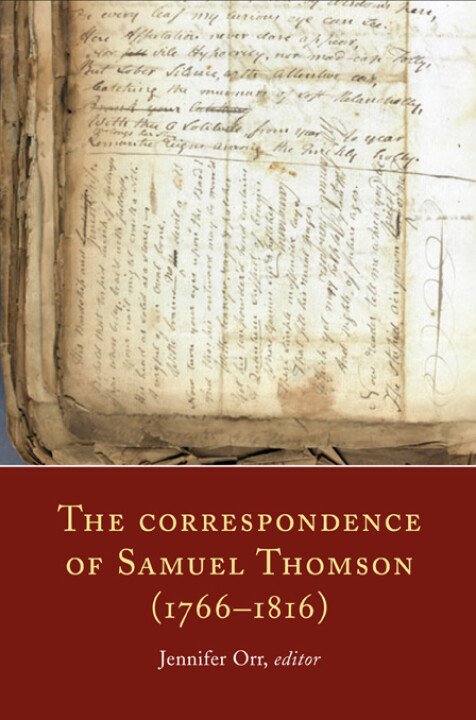The correspondence of Samuel Thomson (1766–1816)
Jennifer Orr, editor
‘An important contribution to the ongoing revision of our understanding of Irish and Scottish literary and cultural history and of the Romantic period … These letters offer an invaluable panorama of Ulster culture and its complex intersections with the larger cultural and political world … Jennifer Orr’s analysis demonstrates her astute understanding of the complexities and nuances f late eighteenth-century Ulster politics, religion, literature and culture. She presents new information and important insights about his crucial period to even the most senior literary scholars and historians', Mary Helen Thuente, Irish Literary Supplement (Fall 2013).
‘The correspondence of Samuel Thomson (1766–1816) consists of letters addressed to Thomson at his home in Crambo Cave, near Templepatrick in County Antrim … The correspondence includes letters from leading literary figures including Robert Burns, who Thomson met in 1794, and the critically acclaimed Ulster poet and United Irishman, James Orr, together with other prominent radicals and eminent Belfast printers and booksellers … Orr provides a cogent introduction to Thomson, eloquently establishing his importance and eminence within his locale, and clearly demonstrating that he was the poet at the centre of a significant literary circle in South Antrim … Thomson stood on the threshold of a cultural and literary change, straddling two centuries which witnessed political upheaval and the emergence of new literary and cultural movements … [this book] demonstrates the importance of publishing archival correspondence … it is an important source for scholars and students alike and is undoubtedly a welcome addition to both Irish and Scottish studies’, Kathryn White, Scottish Literature (2013).
‘Orr has judiciously transcribed and prudently elucidated the original ninety-six letters and near fifty poems contained within a manuscript of 185 folios, archived at Trinity College, Dublin … Part of the abiding value of Orr’s Correspondence will arguably be the inherent critical opportunity for further study, and the links with other Romantic writers’ circles … the edition validates Samuel Thomson as the key figure in crafting and sustaining a Romantic Irish writer’s circle, cultivating local poetic talent and for his essential contribution to Ulster-Scots poetry', David Gray, Eighteenth Century Ireland (2012).
‘Dr Orr has mined a rich source which has significance far beyond the beginnings of Ulster’s literary and linguistic tradition. The collection is also very entertaining', Books Ireland (May 2012).
‘Samuel Thompson is regarded as important, both as a publishing poet and as an exponent of a particular literary culture … [The letters] are tantalizing chiefly because relatively few are known and none of Thomson’s has yet been trace … Individually, the letters illuminate a variety of topics, such as texts and methods used in teaching, the frustrations of publishing by subscription, the centrality of the Belfast newspaper, the Northern Star, to local writers in the early 1790s, and attitudes among Presbyterian ministers … Cumulatively, the correspondence reveals networks underpinned by shared reading and shared attitudes, which extended beyond rural Ulster into Scotland, England and North America … the letters cast a welcome light on the respectable if threadbare world in which the literate and sensitive scraped a living', Toby Barnard, TLS (September 2012).

